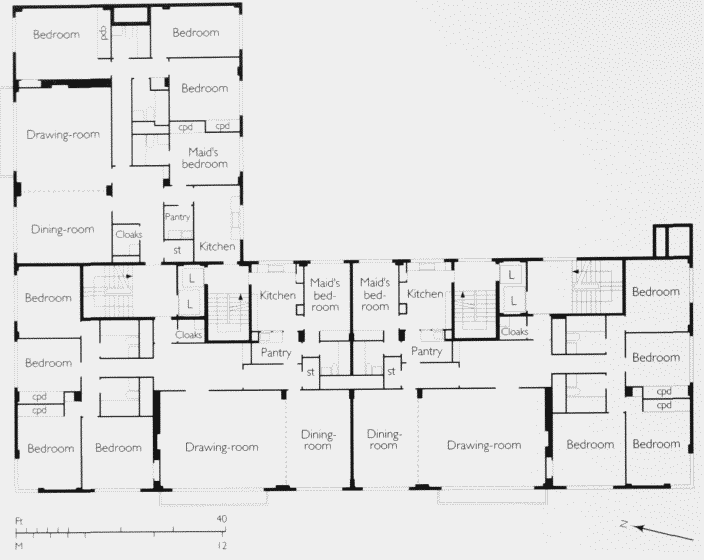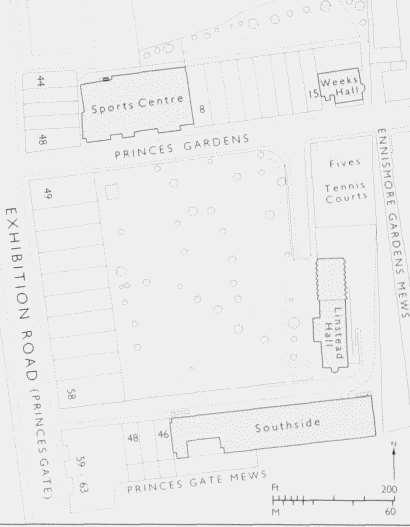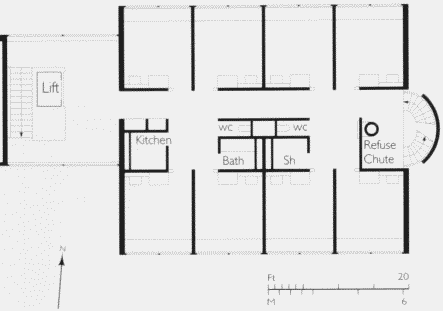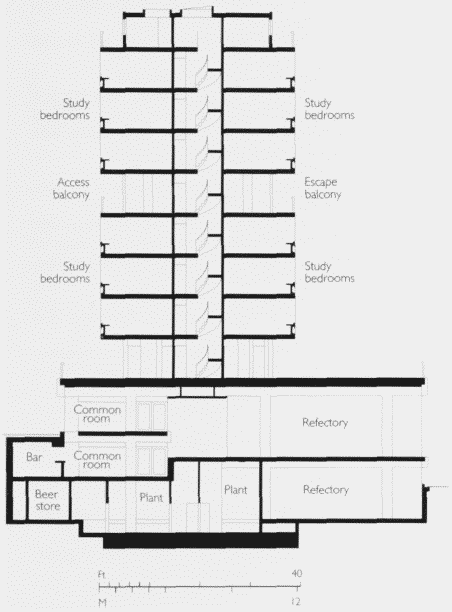Survey of London: Volume 45, Knightsbridge. Originally published by London County Council, London, 2000.
This free content was digitised by double rekeying. All rights reserved.
'Princes Gate and Princes Gardens: the Freake Estate, Redevelopment and Social Change', in Survey of London: Volume 45, Knightsbridge, ed. John Greenacombe (London, 2000), British History Online https://prod.british-history.ac.uk/survey-london/vol45/pp205-209 [accessed 15 April 2025].
'Princes Gate and Princes Gardens: the Freake Estate, Redevelopment and Social Change', in Survey of London: Volume 45, Knightsbridge. Edited by John Greenacombe (London, 2000), British History Online, accessed April 15, 2025, https://prod.british-history.ac.uk/survey-london/vol45/pp205-209.
"Princes Gate and Princes Gardens: the Freake Estate, Redevelopment and Social Change". Survey of London: Volume 45, Knightsbridge. Ed. John Greenacombe (London, 2000), British History Online. Web. 15 April 2025. https://prod.british-history.ac.uk/survey-london/vol45/pp205-209.
In this section
Redevelopment and Social Change
Increasingly unsuited to the needs of post-war society, several of the houses on the Freake estate were converted to high-class apartments or taken over by foreign legations in the 1920s and '30s. In the late 1930s a group of five was replaced by a purpose-built block of flats (Nos 59–63 Princes Gate). This trend continued after the Second World War, with the building of another large apartment block, Montrose Court, and most of the remaining houses sub-divided or turned over to institutional use. In the early 1960s a Mormon church was built on the site of Nos 64–68 Princes Gate. (fn. 1)

Nos 59–63 Princes Gate, typical floor-plan. Adie, Button & Partners, architects, 1937–8
By the early 1950s only two or three houses in Princes Gate remained single dwellings. No. 56, the residence and private gallery of the art collector Count Antoine Seilern, who died in 1978, was probably the last: it is now in the occupation of an American university. Foreign cultural and academic bodies today occupy many of the surviving houses in Princes Gate. In Princes Gardens institutionalization has had a drastic impact on the building fabric, many of the original houses having been pulled down for redevelopment by Imperial College.
Nos 59–63 Princes Gate
This strikingly clean-cut apartment block (Plate 110a ) was erected in 1937–8 to the designs of Adie, Button & Partners. (fn. 3) Built of reinforced concrete faced monolithically in reconstituted Portland stone and with 'wrap-around' corner windows, it much resembles their contemporary Athenaeum Court in Piccadilly. Adie and Button were initially involved in the project, which dated back to 1933, as interior consultants. In April 1935 they took over as the architects from Gordon Jeeves, their Modernist design superseding his more traditional scheme in brick and stone or stucco. The main contractor was E. H. Burgess Ltd, the Trussed Concrete Steel Company Ltd acting as reinforced-concrete engineers.
It was the developers' intention to cover the site more densely, but the London County Council objected to the proposed wing alongside Princes Gate Mews. The resultant L-shaped block is ten full storeys high, over two basement levels, and contains three flats to a floor, with balconies facing Exhibition Road. To the rear is a paved terrace garden with a summer-house. The upper basement was designed as a car-park (entered from the mews) and store-rooms. The lower level was fitted up as a bomb— and gas-proof air-raid shelter, with air-locks, a decontamination chamber and provision for chemical toilets and emergency water and power supplies: proof of 'how the atavistic ideals of twentieth-century nationalism are driving us back to the dungeons and fastnesses of our mediaeval ancestors'. (fn. 4) This facility was conceived in order to utilize the deep excavation necessitated by the site.
The original windows, by Crittall, were metal casements and (opening on to the balconies) sliding-folding doors.
The individual flats were planned with three or four bedrooms, two bathrooms, maid's quarters, and a large reception area divided by sliding doors into living— and dining-rooms (fig. 95, Plate 111a ). Built-in wardrobes were provided in the bedrooms, and the kitchens were 'beautifully fitted with a most impressive array of drawers and cupboards, cellulosed white and having chromium handles'. (fn. 5) There was, however, no attempt at doctrinaire Modernism, and the main entrance halls to the block were conservatively decorated in Georgian style, with fibrous plaster mouldings and gilded capitals (Plate 111b ).
Past residents of the flats include the thermodynamics expert Sir A. C. Glyn Egerton, professor of chemical technology at Imperial College. The Czechoslovak Prime Minister Eduard Benes had offices in the building during the Second World War.
Montrose Court
In 1956 most of the original houses at Nos 32–43 Princes Gate were demolished for the building of Montrose Court. (fn. 6) This new development, a row of five eight-storey blocks of flats fronting Exhibition Road, and two ranges of four four-bedroom houses at the rear, was designed by Bowden, Son & Partners for Finborough Properties Ltd. (fn. 7)
The flats, of reinforced concrete clad in brick and cement render, were built by John Laing & Son, the first four blocks in 1957–8. Construction of the central block, delayed while No. 37 Princes Gate remained standing, was carried out in 1959–61 under the supervision of Clifford Culpin& Partners, architects.
The houses were built by Trollope& Sons in 1958–9. Separated from the flats by a service road, they occupy the former communal garden to the old buildings. Something of a surprise in central London, they are low and chaletlike, with pitched roofs and brick walls with Tyrolean render on the upper storey.
Various alterations and additions to Montrose Court, including penthouses over the flats, were made in 1997–8 (William Gower& Partners, architects).
Imperial College and the redevelopment of Princes Gardens
Almost all the houses in Princes Gardens were vacated during the Second World War, and although only a few suffered bomb-damage (Nos 33–35 alone being 'total losses'), requisitioning and neglect left them generally dilapidated. Wartime use as hostels and offices had altered the character of the area, and the big old houses now seemed obsolescent.
London County Council planners had visions of a National Science Centre in the Exhibition Road area, taking in the site of Princes Gardens, where buildings 'of great national importance' would be erected. (fn. 8) Nothing was to come of this, but the idea was to prove prescient. In the meantime, some sort of redevelopment seemed desirable, and in 1954–5 at least two schemes were in contemplation.

Princes Gardens in 1991: plan showing the buildings erected for Imperial College
One was a straightforward conversion of the houses to flats, for which Lord Rendlesham obtained an agreement for a lease from the Freake Estate. (fn. 9) The other, by Wells Coates, would have entailed the demolition of all the existing buildings, apart from a few houses on the south side. Coates proposed two slab-blocks (135ft and 168ft long), aligned north—south, the internal layout of which was based on his pre-war flats in Palace Gate. They would have been built across the central garden, with the longer block straddling the roadway on the north side. Most of the south side of the square would have been replaced by four-storey terraced houses. (fn. 10)
The availability of Princes Gardens for redevelopment coincided with the enlargement of the Imperial College of Science and Technology under a government initiative to improve training for industry, part of the general post-war expansion of higher education. Between 1953 and 1962 the college received some £17,000,000, mainly to fund building works, and saw its student roll almost double to 3,000. (fn. 11)
Attention was focused initially on the rebuilding of the congested 'island site' between Prince Consort Road and Imperial College Road, where the available development space was reduced by the decision to preserve T. E. Collcutt's Imperial Institute tower. A substantial new site had to be found if the necessary halls of residence and common rooms were to be provided. Just across the road from Imperial College, the six acres of Princes Gardens must have seemed like a campus-in-waiting. The Freake Estate was unwilling to allow partial redevelopment, which might have depressed the value of the remaining houses, and in March 1956 the College agreed to take all three sides on a 199-year building lease. (fn. 12) (fn. 2)

Imperial College, Princes Gardens. Weeks Hall, typical floor-plan with eight study bedrooms. Richard Sheppard, Robson& Partners, architects, 1958–9
Norman& Dawbarn, the College's architects, were too heavily involved with work on the island site, and with building the BBC Television Centre at White City, to take on the new development. Accordingly, another firm was sought and in August 1956 Richard Sheppard, Robson & Partners were given the commission. By December the outlines had been agreed with the college planning committee, headed by the new Rector, Sir Patrick Linstead. (fn. 13)
The scheme provided for three eleven-storey ranges, comprising fourteen halls of residence, set round the square garden in the traditional collegiate manner (Plate 106c ).
Refectories and common rooms were to be concentrated within the south block, scheduled to be developed first, while the northern range, the intended final stage, was to include an underground sports centre.
The new buildings, of reinforced-concrete cross-wall and slab-floor construction clad in precast concrete sections, were based on a module or 'set' of rooms, one set comprising eight study bedrooms, with bathroom, showerroom, and water-closets, served by an internal staircase. Each hall of residence was to be built up from three-storey stacks of these sets, each stack having its own open-plan 'gallery' floor for communal recreational and service facilities. Within the individual halls, the planning was contrived to foster social contacts and a 'meaningful communal life'. (fn. 14)
Contemporary reaction to the scheme was generally favourable. The Architects' Journal welcomed 'the first attempt we have seen to interpret the collegiate idea of student accommodation in an acceptable, twentieth-century, architecture'. The Spectator, nothing parallels between its 'boldly plastic architecture' and Le Corbusier's Pavillon Suisse of 1932 for the Paris University City, saw it as an 'exercise of symphonic complexity'. The Builder, however, was concerned at the 'shut-in feeling' conveyed by the architects' perspective exhibited at the Royal Academy summer show. (fn. 15) In the event, financial constraints obliged the College to develop the site piecemeal and not one side has been finished according to the original vision (fig. 96).
As it happened, the first building to be erected, Weeks Hall (Plate 97c ), was an addition to the planned ensemble. Early in 1957 the engineering firm Vickers offered the College £150,000 to pay for a hall of residence. As no independent site was available, it was decided to accommodate the extra building at the eastern end of the proposed northern range (which was never built), where it was to act as a visual 'stop'. Named after Lord Weeks, the former chairman of Vickers, the hall was erected in 1958–9 by Tersons Ltd, for £126,000, and formally opened in September 1959. (fn. 16)
Vickers had asked that the building should have an individual character of its own, while relating to the character of the rest of the development. The result (fig. 97, Plate 97c ) is a vertically arranged version of the blocks already planned, using a broadly similar modular set of eight rooms (though without an internal staircase). There are eight floors of study bedrooms and a warden's penthouse flat. Under the terms of Vickers' gift, the premises were to be made available to the company for conferences during student vacations, and a 50-seat assembly room was accordingly provided on the ground floor (Plate 107c ).
In construction and finish, the building was closely modelled on the intended long ranges. Indeed, Weeks Hall became a 'testing-ground' for the detailed design of the later buildings. It is clad in precast concrete sections mostly faced with Cornish granite aggregate. Lighter-coloured Norwegian quartz aggregate is used for facing the sill units and the external secondary staircase on the eastern flank of the building. Where exposed to view, the concrete structure is toned with Cornish Lee Moor sand in the mix. The window frames of the study bedrooms are of teak, untreated externally; other windows have painted metal frames. On the west side is a fully glazed tower containing the main stairs and lift, intended as the buffer between the building and the proposed range to the west. The precast, semielliptical escape staircase on the east side was later adopted as the pattern for the access staircases in the south and east blocks.

Imperial College, Princes Gardens. Southside halls, section looking east. Richard Sheppard, Robson& Partners, architects, 1960–3
Inside, the main structural walls were left in their boardmarked state (the subject of some carping by a few early users of the building). In the study bedrooms the walls were plastered and white-painted, with some fitted furniture and a full-length window-seat finished in terrazzo. (fn. 17)
Weeks Hall was followed in 1960–3 by Southside, an eleven-storey range containing four halls of residence (Falmouth, Tizzard, Keogh and Selkirk), refectories, kitchens, bars and common rooms (fig. 98, Plate 106a , 106b ). Built by Wilson Lovatt& Sons, and formally opened in October 1963, it takes up most of the south side. (The remaining houses, Nos 46–48, occupy the site of a now-abandoned extension.) As at Weeks Hall, the exterior is faced with panels of Cornish and Norwegian quartz aggregate, and the predominating interior finish is béton brut, 'well offset by warm, heavy timber ceilings, rich joinery, ample soft furniture and carpets' (Plate 107b ). (fn. 18)
Two more buildings were erected in the later 1960s, both by Higgs& Hill to Sheppard, Robson's designs. Linstead Hall, built in 1966–8 as the first phase of the east-side development, carries on the architectural idiom established by Weeks Hall and Southside (Plate 106a ). On the north side, the Sports Centre (1967–8), constructed within the basement space of the former Nos 1–7, was designed as the footing for further halls of residence, which have yet to be built. (fn. 19)
In 1973 Norman& Dawbarn, who had taken over from Sheppard, Robson as architects for the site, produced an ambitious three-phase plan for the completion of the north and east sides, beginning with a new hall over the sports centre. (fn. 20) The granting of Listed Building status to Nos 8–15 Princes Gardens, and local opposition to the height of the proposed buildings, necessitated considerable modifications. When construction work eventually began, in August 1978, it was confined to a relatively modest extension to Linstead Hall (Plate 107a ), paid for by an anonymous benefaction. Built by Walter Lawrence& Sons Ltd, and completed in 1980, this comprises four storeys of living accommodation over a glazed semi-basement. The reinforced-concrete structure is clad in precast concrete panels faced with white calcium-silicate brick. All the study bedrooms along the 'serrated' main façade are angled to face south-west. (fn. 21) The rest of the east side remains undeveloped and is currently occupied by tennis and fives courts.
Now that the original Corbusian concept has been abandoned, the redevelopment of Princes Gardens seems set to continue incrementally as finances permit, and architecturally as the fashion of the day dictates. The issue of conservation, hardly in evidence in the 1950s, now looms large as a factor in the planning process. In 1992 a development scheme for the entire South Kensington campus was drawn up by Foster and Partners, and a number of new buildings have now been projected.
At the time of writing (2000) plans include the construction of additional living accommodation on the north and east sides. On the north side the proposed range, to be built over the existing sports centre, will 'echo' Freake's houses adjoining. It is also intended to build five mewshouses adjacent to Southside in Princes Gate Mews. They will be in a style 'sympathetic' to the 1960s block. (fn. 22)